Fun runs started as simple neighborhood gatherings focused on community and health. Over time, organizers added fundraising goals, inspired by increased community involvement and sponsorships from local businesses and corporations. Innovations like themed events, engaging marketing, and social media boosted participation and awareness. These efforts transformed fun runs into major charity fundraisers, turning community spirit into significant dollars for causes. If you stay tuned, you’ll discover how strategic approaches continue to grow their impact even further.
Key Takeaways
- Fun runs originated as informal neighborhood gatherings focused on participation and community bonding.
- They evolved to include cultural elements, music, and larger organized events to attract bigger crowds.
- The shift to fundraising emphasized community involvement, volunteer engagement, and sustainable support strategies.
- Incorporation of sponsorships, themed campaigns, and innovative course designs boosted visibility and participation.
- Use of gamification, social media, and virtual engagement transformed fun runs into powerful tools for charitable fundraising.
The Origins of Community Fun Runs
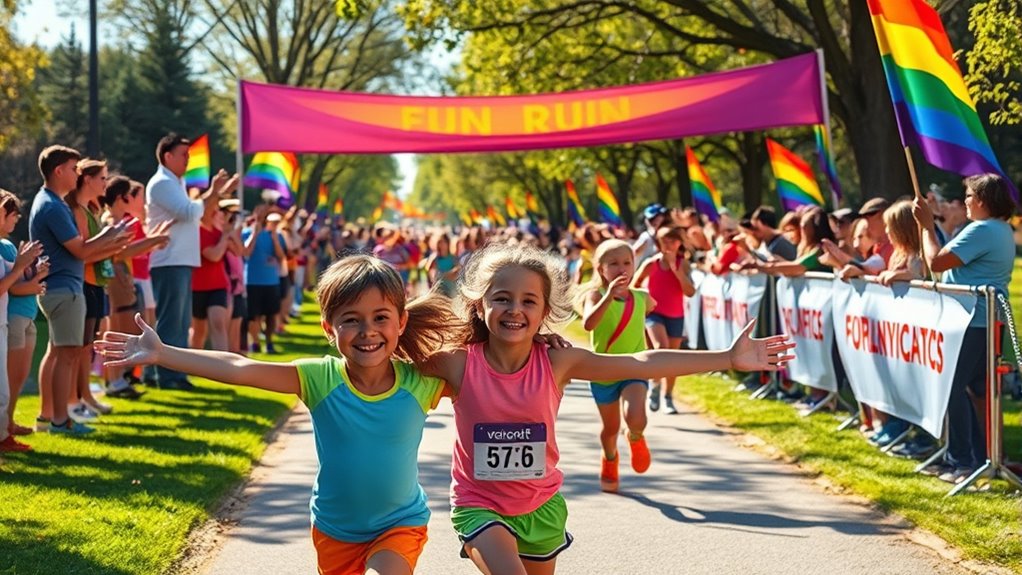
Community fun runs have become popular events that bring neighbors together while promoting health and wellness. These races often stem from local traditions, where communities gather annually to celebrate shared history or seasonal festivals. These events serve as a good example of how community spirit can be strengthened through organized activities. The origins of community fun runs trace back to small neighborhood gatherings organized informally, emphasizing participation over competition. Over time, race organization evolved to handle larger crowds, making events more structured and accessible. Local traditions played a key role in shaping these runs, often incorporating cultural elements, music, and community pride. As they grew in popularity, organizers began to see opportunities for fundraising and charity work, but initially, these fun runs served as a way for residents to connect and promote a healthy lifestyle. Their roots remain deeply embedded in community spirit and tradition, which continue to inspire new generations of participants.
The Shift Toward Fundraising Goals
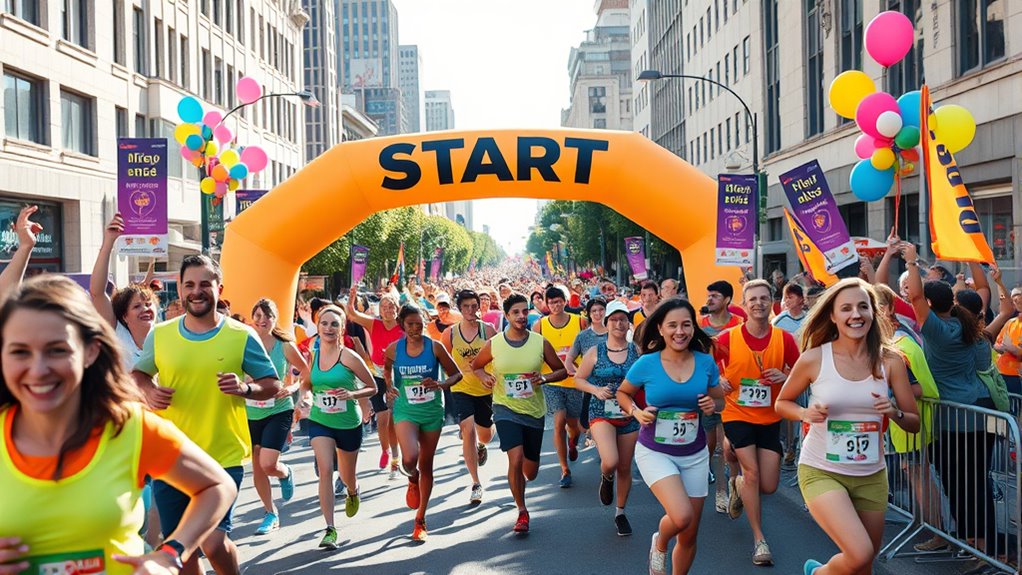
You’ll notice that more community members are getting involved in fun runs, making fundraising efforts stronger than ever. This increased engagement highlights a shift toward larger philanthropic goals. As a result, organizers are now focusing more on making a meaningful impact rather than just hosting events. Implementing best practices in fundraising can further enhance the effectiveness of these efforts. Additionally, understanding the operating hours of venues where events are held can help maximize participation and support. Incorporating Kia Tuning techniques into event promotions can also attract more participants and sponsors, boosting overall success. Building a strong networking strategy is essential for expanding outreach and securing additional resources.
Growing Community Engagement
Have fun runs and charity events increasingly shifted their focus from merely raising awareness to actively meeting fundraising goals. This change boosts community engagement by emphasizing local traditions that bring people together. You’ll notice that events now encourage more volunteer participation, making everyone feel invested in the cause. Communities see these runs as opportunities to strengthen bonds while supporting important initiatives. Fundraising efforts become more personalized, with local businesses and residents rallying around shared goals. This evolution reflects a broader trend of community-driven initiatives fostering stronger local connections. These initiatives often incorporate elements of local culture, which further enhances community involvement and pride. Additionally, the integration of eco-friendly materials and sustainable practices in event organization underscores a commitment to sustainable living, resonating with environmentally conscious participants. The increased use of recyclable materials in event logistics further demonstrates a dedication to reducing environmental impact. This shift helps foster a sense of pride and ownership within the community, motivating more participation. As a result, fun runs transform from simple gatherings into powerful tools for collective action, turning every step into a step toward meaningful change.
Increased Philanthropic Focus
As fun runs and charity events evolve, their focus has shifted from simply raising awareness to actively meeting specific fundraising goals. You now see organizers employing diverse fundraising methods, such as online donation platforms, sponsorships, and peer-to-peer campaigns, to maximize contributions. Volunteer recruitment has also become a strategic priority, helping to increase event capacity and engagement. By rallying volunteers, you can expand outreach and foster a sense of community ownership, which boosts donations. This increased philanthropic focus means that every aspect of the event is geared toward measurable financial targets, rather than just visibility. As a result, fun runs now serve as powerful tools for sustainable fundraising, directly impacting the causes they support and encouraging participants to become long-term donors.
Key Events That Boosted Popularity
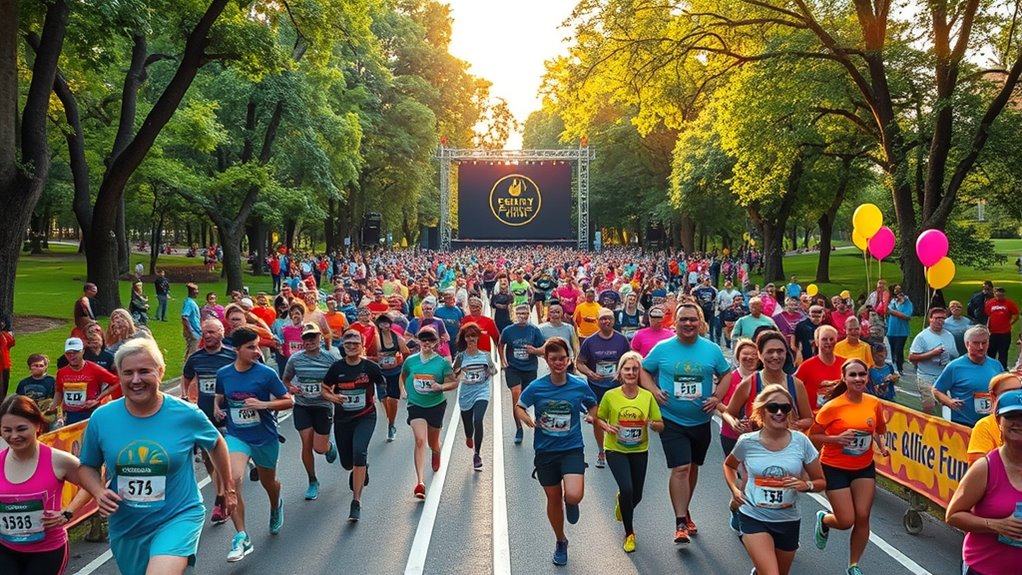
One of the most significant events that boosted the popularity of fun runs and charity donations was the 2010 launch of the “Race for a Cause” campaign. This initiative emphasized incorporating marathon traditions, like themed bibs and finisher medals, to attract more participants. Additionally, the campaign focused heavily on innovative race course design, making routes more engaging and accessible for all skill levels. By emphasizing tradition and creating memorable experiences, organizers drew larger crowds and increased awareness. The event’s success inspired other charities to adopt similar strategies, integrating marathon customs into fun runs. As a result, more people saw these events as meaningful and enjoyable, fueling their growth into major fundraising activities. This combination of tradition and design truly elevated the profile of charity fun runs.
The Role of Corporate Sponsorships and Partnerships
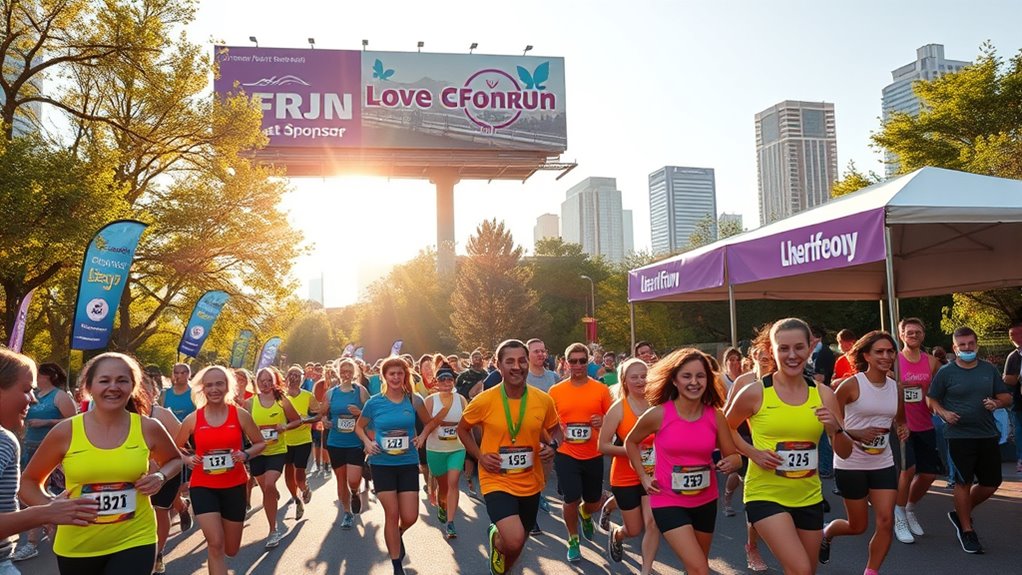
Corporate sponsorships and partnerships play a pivotal role in the success of fun runs and charity donations by providing essential funding, resources, and visibility. They boost the event’s credibility and attract more participants by leveraging corporate branding. Sponsorship benefits extend beyond financial support, offering promotional opportunities that enhance brand recognition and community engagement. With strong corporate partnerships, you might imagine:
- Branded banners lining the racecourse
- Participants wearing shirts with sponsor logos
- On-site booths showcasing products and services
- Media coverage highlighting corporate involvement
- Social media shout-outs boosting awareness
These elements create a vibrant event atmosphere and help raise more funds. By aligning with reputable companies, you increase trust, expand outreach, and ensure the event’s long-term growth. Sponsorships truly transform fun runs into powerful charity engines.
Innovations in Event Marketing and Engagement
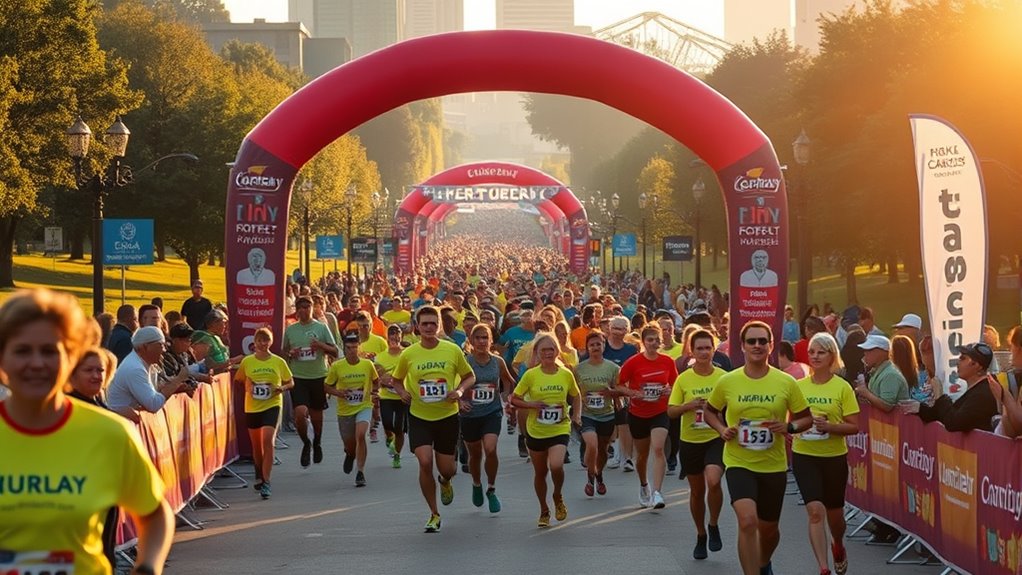
You can boost participation by leveraging social media strategies that create buzz and encourage sharing. Gamification techniques, like leaderboards or reward systems, turn the event into an engaging challenge. These innovations make your fun run more memorable and motivate more donors to join in.
Social Media Strategies
Social media has become a powerful tool for innovating event marketing and boosting engagement in fun runs and charity donations. You can leverage virtual challenges to reach participants worldwide and keep them motivated. Collaborating with influencers amplifies your message, encouraging their followers to join and donate. To create vivid imagery, think of:
- Participants sharing live updates of their runs
- Hashtag campaigns trending online
- Virtual badges awarded for completing challenges
- Influencers posting motivational videos
- Real-time leaderboards sparking friendly competition
These strategies foster community spirit and excitement. By integrating virtual challenges and influencer collaborations into your social media plan, you turn ordinary events into memorable, shareable experiences that drive donations and expand your reach.
Gamification Techniques
Gamification techniques are transforming how organizers engage participants and boost contributions in fun runs and charity events. Leaderboard gamification motivates runners by displaying real-time rankings, encouraging friendly competition and persistent effort. As participants see their progress, they’re more likely to stay committed and increase their donations. Badge collection adds an element of achievement, rewarding runners for milestones like completing distances or fundraising goals. These digital badges foster a sense of accomplishment and motivate continued involvement. By integrating leaderboards and badge systems into event apps or websites, organizers create interactive experiences that boost engagement. This approach not only keeps participants motivated but also enhances overall event visibility and fundraising success. Gamification turns a simple run into an exciting, rewarding experience that benefits everyone involved.
The Impact on Charitable Giving and Community Wellness
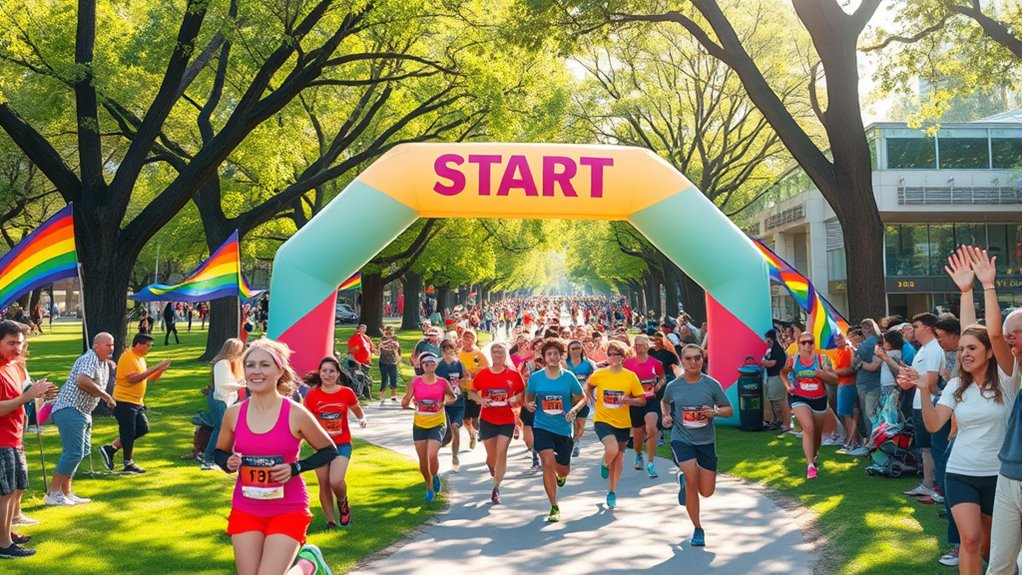
How do fun runs and charity events influence community well-being and giving habits? They boost community spirit and encourage ongoing support through effective fundraising strategies and volunteer recruitment. These events foster a sense of shared purpose, inspiring participants to give beyond the race day. Imagine:
- Local streets filled with runners and smiling faces
- Community members cheering along the route
- Volunteers handing out water and medals
- Families celebrating together afterward
- Donors excitedly contributing online or on-site
This vibrant atmosphere not only raises funds but also strengthens social bonds. Participants often become repeat donors, helping sustain long-term support for causes. By engaging people at grassroots levels, these events promote healthier communities and more consistent charitable giving.
Frequently Asked Questions
How Have Technology Advancements Changed Fun Run Participation?
You’ve seen how technology advancements have transformed fun run participation. Virtual participation allows you to join races from anywhere, breaking geographical barriers, while social media integration keeps you connected and motivated. These tools make it easier to register, share your progress, and encourage others to contribute. As a result, more people get involved, and fun runs grow bigger, raising more money for charity than ever before.
What Challenges Do Organizers Face in Scaling Charity Fun Runs?
When scaling charity fun runs, you face challenges like securing enough corporate sponsorship to cover costs and attract participants. Volunteer coordination becomes more complex as you need more hands to manage larger crowds and logistics. Balancing funding, ensuring safety, and maintaining engagement also pose hurdles, requiring strategic planning and strong partnerships. Overcoming these obstacles helps you expand your event’s reach and maximize its charitable impact.
How Do Fun Runs Influence Long-Term Donor Engagement?
Imagine planting seeds of goodwill—fun runs foster long-term donor engagement by creating memorable community moments. You’ll find volunteers enthusiastic to help through targeted recruitment, strengthening connections. These events serve as vibrant community outreach, encouraging ongoing participation and support. As donors experience the joy and impact firsthand, their commitment deepens, transforming one-time contributions into lasting relationships that sustain your cause well beyond the race day.
Are There Geographic or Demographic Trends in Fun Run Popularity?
You’ll notice that fun run popularity varies based on cultural influences and regional participation. In some areas, community traditions and local events boost interest, while others see less engagement. Demographics like age and socioeconomic status also shape participation, with younger or more active populations more likely to join. Recognizing these trends helps organizers tailor events to local interests, making fun runs more inclusive and successful across different regions and cultures.
What Future Innovations Could Further Enhance Charity Fun Runs?
Imagine a charity fun run where virtual participation and wearable tech boost engagement. You could track runners’ progress in real-time, share live updates online, and motivate supporters worldwide. Future innovations might include augmented reality to create immersive experiences or personalized fitness challenges connected to wearable devices. These advancements would make charity runs more inclusive, interactive, and fun, increasing donations and awareness while connecting participants across distances effortlessly.
Conclusion
As you see, fun runs have quietly evolved into meaningful traditions that bring communities together and support essential causes. While the focus on enjoyment may seem lighthearted, it gently reminds us that positive change often begins with simple steps. By participating, you help foster a more connected, compassionate world—one stride at a time. So, keep the momentum going; sometimes, the smallest actions hold the greatest potential for transformation.









